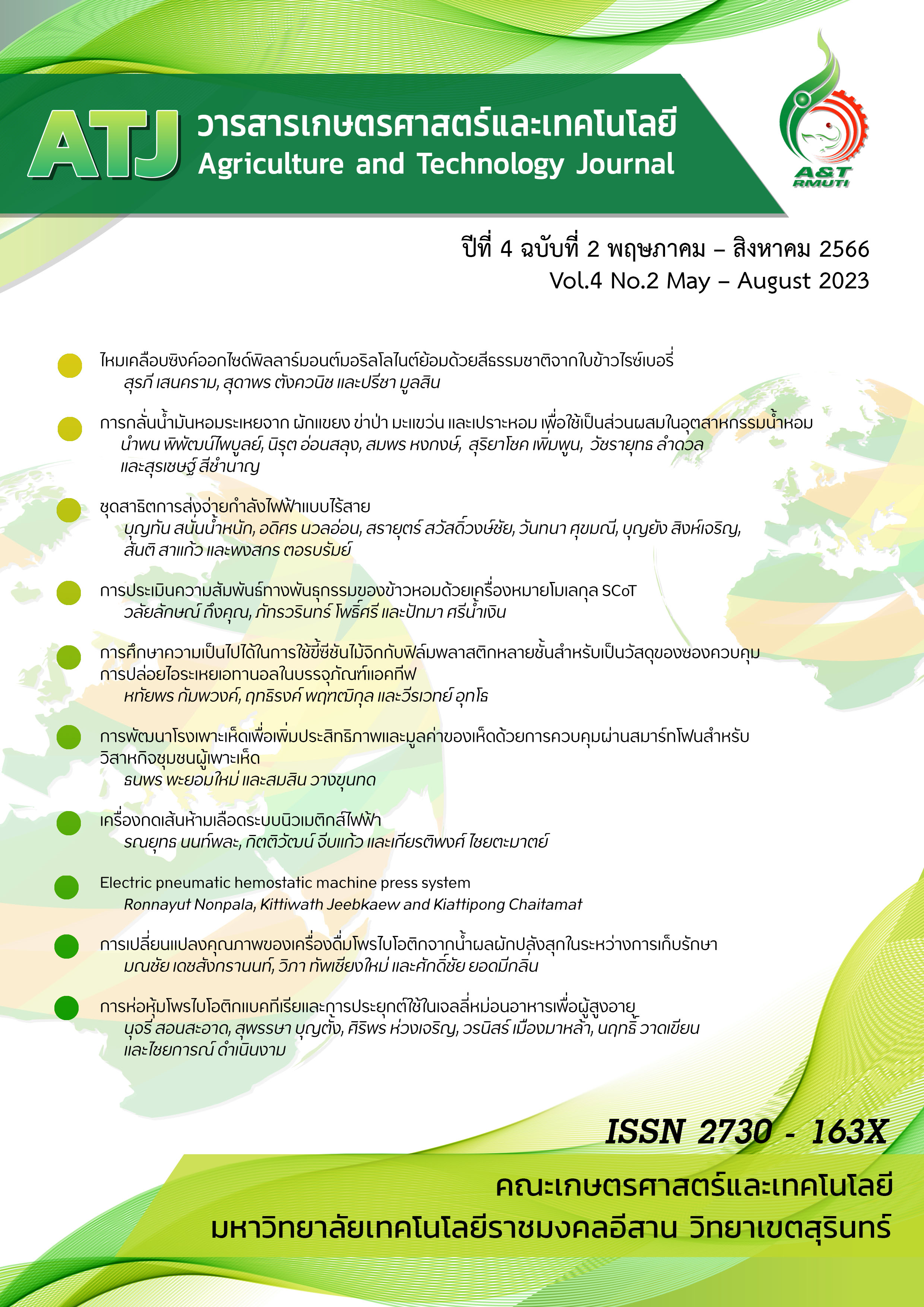Different Plant Extracts Against the Early Blight (Alternaria solani) on Tomato (Solanum lycoperisicum)
คำสำคัญ:
Alternaria solani, Allium sativum L., Carica papaya, Azadirachta indica, Phytochemical compoundsบทคัดย่อ
Alternaria solani, the causal agent of early blight disease, is one of the most destructive pathogens of Solanumm lycopersicum and reduces productivity by approximately 80%. The aim of this study was to assess the efficiency of three different plant extracts to control Alternaria solani on tomato under field conditions. A Randomized Complete Block Design (RCBD) was used with four replications and four treatments, namely Allium sativum L., Carica papaya, Azadirachta indica, and control (water). Allium sativum L. (Garlic), Carica papaya (paw paw) and Azadirachta indica (Neem) extracts were observed to be more effective on disease severity and disease incidence during week four with a significant difference (P<0.01) compared to the control treatment. The plot treated with Carica papaya showed the highest total yield, followed by Azadirachta indica and Allium sativum L. (1052.8g, 639.8g, and 566.8g, respectively) with significant differences (P<0.01) while the control treatment produced 265g. The application of plant extracts revealed a significant reduction of early blight disease as well as an increased total yield of tomatoes compared to the control treatment.
เอกสารอ้างอิง
Adebo O.A. and Gabriela Medina-Meza I. (2020). Impact of fermentation on the phenolic compounds and
antioxidant activity of whole cereal grains: A mini review. Molecules. 25(4): 927. DOI: 10.3390/molecules25040927
Akila G. and Sathiy C.E.A. (2012). Treatment of tomato plants with yeast extract glucan induce chitinase activity, resistance to Alternaria solani, the causal agent of early blight disease. International Journal of Biology. Pharmacy and Allied Sciences. 1: 1492-1499.
Anusha B. (2003). Botanical fungicides for rice sheath blight management. M.S. (Ag). Thesis. Tamil Nadu Agricultural University. Coimbatore. India.
Baka Z.A. and Rashad Y.M. (2016). Alternative control of early blight of tomato using plant extracts from Acacia nilotica, Achillea fragrantissima and Calotropis procera. Phytopathologia Mediterranea. 55(1). 121-129.
Baskaran C., Velu S. and Kumaran K. (2012). The efficacy of Carica papaya leaf extract on some bacterial and a fungal strain by well diffusion method. Asian Pacific Journal of Tropical Disease. 2: S658-S662.
Bayan L., Koulivand P.H. and Gorji A. (2014). Garlic: a review of potential therapeutic effects. Avicenna journal of phytomedicine. 4(1): 1-14.
Buer C.S. and Muday G.K. (2004). The transparent testa4 mutation prevents flavonoid synthesis and alters auxin transport and the response of Arabidopsis roots to gravity and light. The Plant Cell. 16(5): 1191-1205.
Das S., Chaudhari A.K., Singh A., Singh V.K., Dwivedy A.K. and Dubey N.K. (2020). Foodborne microbial toxins and their inhibition by plant-based chemicals. In Functional and preservative properties of phytochemicals. Elsevier. 165-207.
Dheeb B.I. (2015). Antifungal activity of alkaloids and phenols compounds extracted from black pepper Piper nigrum against some pathogenic fungi. Journal of Biotechnology Research Centre. 9(2): 46-54.
El-Kholy R., El-Samadesy A., Helalia A. and El-Ballat E. (2021). Efficacy of certain chemical fungicides and biofungicides on early blight disease in tomato under field conditions. Al-Azhar Journal of Agricultural Research. 46(2): 145-153.
Foolad M.R., Merk H.L. and Ashrafi H. (2008). Genetics, genomics and breeding of late blight and early blight resistance in tomato. Critical Reviews in Plant Sciences. 27(2): 75-107.
Goussous S.J., Abu el-Samen F.M. and Tahhan R.A. (2010). Antifungal activity of several medicinal plants extracts against the early blight pathogen (Alternaria solani). Archives of phytopathology and plant protection. 43(17): 1745-1757.
Harris J., Cottrell S., Plummer S. and Lloyd D. (2001). Antimicrobial properties of Allium sativum (garlic). Applied microbiology and biotechnology. 57(3): 282-286.
Iram W., Anjum T., Iqbal M., Ghaffar A. and Abbas M. (2015). Mass spectrometric identification and toxicity assessment of degraded products of aflatoxin B1 and B2 by Corymbia citriodora aqueous extracts. Scientific reports. 5(1): 1-15.
Jantasorn A., Moungsrimuangdee B. and Dethoup T. (2016). In vitro antifungal activity evaluation of five plant extracts against five plant pathogenic fungi causing rice and economic crop diseases. Journal of Biopesticides. 9(1): 1-7.
Kagale S., Marimuthu T., Thayumanavan B., Nandakumar R. and Samiyappan R. (2004). Antimicrobial activity and induction of systemic resistance in rice by leaf extract of Datura metel against Rhizoctonia solani and Xanthomonas oryzae pv. oryzae. Physiological and Molecular Plant Pathology. 65(2): 91-100.
Kemmitt G. (2002). Early blight of potato and tomato. The Plant Health Instructor. DOI: https://doi.org/ 10.1094/PHI-I-2002-0809-01.
Khan N., Mishra A. and Nautiyal C.S. (2012). Paenibacillus lentimorbus B-30488r controls early blight disease in tomato by inducing host resistance associated gene expression and inhibiting Alternaria solani. Biological control. 62(2): 65-74.
Kimani, V. (2014) Bio-Pesticides Development, Use and Regulation in Kenya. Regional Experts Workshop on Development, Regulation and Use of Bio-Pesticides in East Africa, Nairobi, Kenya, 22-23 May 2014.
Latha P., Anand T., Ragupathi N., Prakasam V. and Samiyappan R. (2009). Antimicrobial activity of plant extracts and induction of systemic resistance in tomato plants by mixtures of PGPR strains and Zimmu leaf extract against Alternaria solani. Biological control. 50(2): 85-93.
Lengai G.M. and Muthomi J. W. (2018). Biopesticides and their role in sustainable agricultural production. Journal of Biosciences and Medicines. 6(06): 7. DOI: https://doi.org/10.3389/fsufs.2021.619058.
Loi M., Paciolla C., Logrieco A.F. and Mulè G. (2020). Plant bioactive compounds in pre-and postharvest management for aflatoxins reduction. Frontiers in Microbiology. 11: 243. DOI: 10.3389/fmicb.2020.00243.
Martinez J.A. (2012). Natural fungicides obtained from plants. In D. Dhanasekaran, N. Thajuddin and A. Panneerselvam. Fungicides for plant and animal diseases. IntechOpen. DOI: 10.5772/26336. Mohana D. and Raveesha K. (2007). Anti-fungal evaluation of some
Mohana D. and Raveesha K. (2007). Anti-fungal evaluation of some plant extracts against some plant pathogenic field and storage fungi. Journal of Agricultural Technology. 4(1): 119-137.
Mohotti S., Rajendran S., Muhammad T., Strömstedt A.A., Adhikari A., Burman R., De Silva E., Göransson U.,Hettiarachchi C. and Gunasekera S. (2020). Screening for bioactive secondary metabolites in Sri Lankan medicinal plants by microfractionation and targeted isolation of antimicrobial flavonoids from Derris scandens. Journal of Ethnopharmacology. 246: 112158. DOI: https://doi.org/10.1016/j.jep.2019.112158
Mugao L.G., Gichimu B.M., Muturi P.W. and Njoroge E.K. (2021). Essential oils as biocontrol agents of early and late blight diseases of tomato under greenhouse conditions. International Journal of Agronomy. 2: 1-10. DOI:10.1155/2021/5719091.
Naik S., Narute T. and Khaire P. (2020). In vitro efficacy of plant extract (botanicals) against Alternaria solani (early blight of tomato). Journal of Pharmacognosy and Phytochemistry. 9(5): 614-617.
Noshad Q., Anjum M., Malik N.Z., Ajaib M., Jehangir S. and Riaz M. (2018). Investigations of phytochemical and antifungal activity of Carica papaya L. leaves. Pure and Applied Biology. 7(1): 309-314.
Pandey S., Giri V.P., Tripathi A., Kumari M., Narayan S., Bhattacharya A., Srivastava S. and Mishra A. (2020). Early blight disease management by herbal nanoemulsion in Solanum lycopersicum with bio-protective manner. Industrial crops and products. 150: 112421. DOI: https://doi.org/10.1016/j.indcrop.2020.112421
Parvin I., Mondal C., Sultana S., Sultana N. and Aminuzzaman F. (2021). Pathological survey on early leaf blight of tomato and in vitro effect of culture media, temperature and pH on growth and sporulation of Alternaria solani. Open Access Library Journal. 8(3): 1-17.
Prakash B., Kumar A., Singh P.P. and Songachan L. (2020). Antimicrobial and antioxidant properties of phytochemicals: Current status and future perspective. Functional and preservative properties of phytochemicals. 1-45.
Righini H., Francioso O., Di Foggia M., Martel Quintana A. and Roberti R. (2021). Assessing the potential of the Terrestrial Cyanobacterium Anabaena minutissima for controlling Botrytis cinerea on tomato fruits. Horticulturae. 7(8): 210. DOI: https://doi.org/10.3390/horticulturae7080210.
Ritika B. and Utpal D. (2014). An overview of fungal and bacterial biopesticides to control plant pathogens/diseases. African Journal of Microbiology Research. 8(17): 1749-1762.
Romanazzi G., Lichter A., Gabler F.M. and Smilanick J. L. (2012). Recent advances on the use of natural and safe alternatives to conventional methods to control postharvest gray mold of table grapes. Postharvest Biology and Technology. 63(1): 141-147.
Roy C., Akter N., Sarkar M., PK M., Begum N. and Zenat E. (2019). Control of early blight of tomato caused by Alternaria solani and screening of tomato varieties against the pathogen. The Open Microbiology Journal. 13: 41-50.
Salazar-Aranda R., Granados-Guzmán G., Pérez-Meseguer J., González G. M. and Waksman de Torres N. (2015). Activity of polyphenolic compounds against Candida glabrata. Molecules. 20(10): 17903-17912.
Sallam N.M.A. (2011). Control of tomato early blight disease by certain aqueous plant extracts. Plant Pathology Journal. 10(4): 187-191.
Satya V., Radhajeyalakshmi R., Kavitha K., Paranidharan V., Bhaskaran R. and Velazhahan R. (2005). In vitro antimicrobial activity of zimmu (Allium sativum L., Allium cepa L.) leaf extract. Archives of phytopathology and plant protection. 38(3): 185-192.
Sharma B. and Kumar P. (2009). In vitro antifungal potency of some plant extracts against Fusarium oxysporum. International Journal of Green Pharmacy. 3(1). DOI:10.4103/0973-8258.49377.
Singh U., Sarma B., Mishra P. and Ray A. (2000). Antifungal activity of venenatine, an indole alkaloid isolated from Alstonia venenata. Folia microbiologica. 45(2): 173-176.
Tegegne G., Pretorius J. and Swart, W. (2008). Antifungal properties of Agapanthus africanus L. extracts against plant pathogens. Crop Protection. 27(7): 1052-1060.
Tewari B.B., Subramanian G. and Gomathinayagm, R. (2014). Antimicrobial properties of Carica papaya (Papaya) different leaf extract against E. coli, S. aureus and C. albicans. American Journal of pharmacology and pharmacotherapeutics.
Yang Y.-X., An M.-M., Jin Y.-S. and Chen H.-S. (2017). Chemical constituents from the rhizome of Polygonum paleaceum and their antifungal activity. Journal of Asian natural products research. 19(1): 47-52.
Yoon M.Y., Cha B. and Kim J.C. (2013). Recent trends in studies on botanical fungicides in agriculture. The plant pathology journal. 29(1): 1. DOI: 10.5423/PPJ.RW.05.2012.0072.
ดาวน์โหลด
เผยแพร่แล้ว
เวอร์ชัน
- 19-02-2024 (2)
- 30-08-2023 (1)
รูปแบบการอ้างอิง
ฉบับ
ประเภทบทความ
สัญญาอนุญาต
ลิขสิทธิ์ (c) 2023 วารสารเกษตรศาสตร์และเทคโนโลยี

อนุญาตภายใต้เงื่อนไข Creative Commons Attribution-NonCommercial-NoDerivatives 4.0 International License.
เนื้อหาและข้อมูลในบทความที่ลงตีพิมพ์ในวารสารทดสอบระบบ ThaiJo2 ถือเป็นข้อคิดเห็นและความรับผิดชอบของผู้เขียนบทความโดยตรงซึ่งกองบรรณาธิการวารสาร ไม่จำเป็นต้องเห็นด้วย หรือร่วมรับผิดชอบใดๆ
บทความ ข้อมูล เนื่อหา รูปภาพ ฯลฯ ที่ได้รับการดีพิมพ์ในวารสารทดสอบระบบ ThaiJo2 ถือเป็นลิขสิทธิ์ของวารสารทดสอบระบบ ThaiJo2 หากบุคคลหรือหน่วยงานใดต้องการนำทั้งหมดหรือส่วนหนึ่งส่วนใดไปเผยแพร่หรือเพื่อกระทำการใดๆ จะต้องได้รับอนุญาตเป็นลายลักอักษรณ์จากวารสารทดสอบระบบ ThaiJo2 ก่อนเท่านั้น







